Study on Spatial Characteristics, Health Assessment, and Influencing Factors of Tropospheric Ozone Pollution in Qin–Jin Region, 2013–2022
Abstract
:1. Introduction
2. Data Sources and Methods
2.1. Data Sources
2.2. Research Methods
2.2.1. Analysis of Past (Slope) and Future (Random Forest Machine Learning) Trends
2.2.2. Benmap-Model-Based Health Impact Function and Economic Loss Assessment
2.2.3. GTWR
2.2.4. Kernel Density Analysis
2.2.5. Ozone Sensitivity (FNR)
3. Results and Discussion
3.1. Temporal–Spatial Distribution and Change Trend of Ozone
3.1.1. Characterization of the Interannual Distribution of Tropospheric Ozone
3.1.2. Monthly and Weekly Distribution Characteristics of Tropospheric Ozone
3.1.3. Characterization of Future Ozone Projections Based on Random Forests
3.2. Number of Premature Deaths from Diseases Associated with Ozone Exposure and Health Economic Assessment
3.3. Influencing Factors
3.3.1. Human Factors
3.3.2. Natural Factors
3.3.3. Ozone Precursors
3.4. Control Based on Ozone Sensitivity
4. Conclusions
5. Limitations and Prospects
Author Contributions
Funding
Institutional Review Board Statement
Informed Consent Statement
Data Availability Statement
Conflicts of Interest
References
- Chameides, W.; Walker, J.C.G. A photochemical theory of tropospheric ozone. J. Geophys. Res. 1973, 78, 8751–8760. [Google Scholar] [CrossRef]
- Fang, Y.; Naik, V.; Horowitz, L.; Mauzerall, D. Air pollution and associated human mortality: The role of air pollutant emissions, climate change and methane concentration increases from the preindustrial period to present. Atmos. Chem. Phys. 2013, 13, 1377–1394. [Google Scholar] [CrossRef]
- Booker, F.; Muntifering, R.; McGrath, M.; Burkey, K.; Decoteau, D.; Fiscus, E.; Manning, W.; Krupa, S.; Chappelka, A.; Grantz, D. The ozone component of global change: Potential effects on agricultural and horticultural plant yield, product quality and interactions with invasive species. J. Integr. Plant Biol. 2009, 51, 337–351. [Google Scholar] [CrossRef] [PubMed]
- Lim, C.C.; Hayes, R.B.; Ahn, J.; Shao, Y.; Silverman, D.T.; Jones, R.R.; Garcia, C.; Bell, M.L.; Thurston, G.D. Long-Term Exposure to Ozone and Cause-Specific Mortality Risk in the United States. Am. J. Respir. Crit. Care Med. 2019, 200, 1022–1031. [Google Scholar] [CrossRef]
- Li, K.; Jacob, D.J.; Liao, H.; Shen, L.; Zhang, Q.; Bates, K.H. Anthropogenic drivers of 2013–2017 trends in summer surface ozone in China. Proc. Natl. Acad. Sci. USA 2019, 116, 422–427. [Google Scholar] [CrossRef] [PubMed]
- Lu, X.; Hong, J.; Zhang, L.; Cooper, O.R.; Schultz, M.G.; Xu, X.; Wang, T.; Gao, M.; Zhao, Y.; Zhang, Y. Severe Surface Ozone Pollution in China: A Global Perspective. Environ. Sci. Technol. Lett. 2018, 5, 487–494. [Google Scholar] [CrossRef]
- Dai, H.; Zhu, J.; Liao, H.; Li, J.; Liang, M.; Yang, Y.; Yue, X. Co-occurrence of ozone and PM2.5 pollution in the Yangtze River Delta over 2013–2019: Spatiotemporal distribution and meteorological conditions. Atmos. Res. 2021, 249, 105363. [Google Scholar] [CrossRef]
- Derwent, R.G.; Utembe, S.R.; Jenkin, M.E.; Shallcross, D.E. Tropospheric ozone production regions and the intercontinental origins of surface ozone over Europe. Atmos. Environ. 2015, 112, 216–224. [Google Scholar] [CrossRef]
- Wang, T.; Xue, L.; Brimblecombe, P.; Lam, Y.F.; Li, L.; Zhang, L. Ozone pollution in China: A review of concentrations, meteorological influences, chemical precursors, and effects. Sci. Total Environ. 2017, 575, 1582–1596. [Google Scholar] [CrossRef]
- Jin, X.; Holloway, T. Spatial and temporal variability of ozone sensitivity over China observed from the Ozone Monitoring Instrument. J. Geophys. Res. Atmos. 2015, 120, 7229–7246. [Google Scholar] [CrossRef]
- Li, K.; Jacob, D.J.; Shen, L.; Lu, X.; De Smedt, I.; Liao, H. Increases in surface ozone pollution in China from 2013 to 2019: Anthropogenic and meteorological influences. Atmos. Chem. Phys. 2020, 20, 11423–11433. [Google Scholar] [CrossRef]
- Liu, Y.; Wang, T. Worsening urban ozone pollution in China from 2013 to 2017—Part 2: The effects of emission changes and implications for multi-pollutant control. Atmos. Chem. Phys. 2020, 20, 6323–6337. [Google Scholar] [CrossRef]
- Gong, S.; Zhang, L.; Liu, C.; Lu, S.; Pan, W.; Zhang, Y. Multi-scale analysis of the impacts of meteorology and emissions on PM2.5 and O3 trends at various regions in China from 2013 to 2020 2. Key weather elements and emissions. Sci. Total Environ. 2022, 824, 153847. [Google Scholar] [CrossRef] [PubMed]
- Wang, W.; van der A, R.; Ding, J.; van Weele, M.; Cheng, T. Spatial and temporal changes of the ozone sensitivity in China based on satellite and ground-based observations. Atmos. Chem. Phys. 2021, 21, 7253–7269. [Google Scholar] [CrossRef]
- Cao, J.-J.; Zhang, T.; Chow, J.C.; Watson, J.G.; Wu, F.; Li, H. Characterization of Atmospheric Ammonia over Xi’an, China. Aerosol Air Qual. Res. 2009, 9, 277–289. [Google Scholar] [CrossRef]
- Yan, K.; Yang, C.A.-O.; Zhang, H.; Ye, D.; Liu, S.; Chang, J.; Jiang, M.; Zhao, M.; Fang, Y. Impact of the zero-mark-up drug policy on drug-related expenditures and use in public hospitals, 2016–2018: An interrupted time series study in Shaanxi. BMJ Open 2020, 10, e037034. [Google Scholar] [CrossRef] [PubMed]
- Breiman, L.; Friedman, J.H.; Olshen, R.A.; Stone, C.J.J.B. Classification and Regression Trees. Biometrics 1984, 40, 874. [Google Scholar]
- Breiman, L. Random Forests. Mach. Learn. 2001, 45, 5–32. [Google Scholar] [CrossRef]
- Turner, M.; Jerrett, M.; Pope, C.; Krewski, D.; Gapstur, S.; Diver, W.; Beckerman, B.; Marshall, J.; Su, J.; Crouse, D.; et al. Long-Term Ozone Exposure and Mortality in a Large Prospective Study. Am. J. Respir. Crit. Care Med. 2015, 193, 1134–1142. [Google Scholar] [CrossRef]
- Yin, P.; Chen, R.; Wang, L.; Meng, X.; Liu, C.; Niu, Y.; Lin, Z.; Liu, Y.; Liu, J.; Qi, J.; et al. Ambient Ozone Pollution and Daily Mortality: A Nationwide Study in 272 Chinese Cities. Environ. Health Perspect 2017, 125, 117006. [Google Scholar] [CrossRef]
- Shang, Y.; Sun, Z.; Cao, J.; Wang, X.; Zhong, L.; Bi, X.; Li, H.; Liu, W.; Zhu, T.; Huang, W. Systematic review of Chinese studies of short-term exposure to air pollution and daily mortality. Environ. Int. 2013, 54, 100–111. [Google Scholar] [CrossRef] [PubMed]
- Huang, B.; Wu, B.; Barry, M. Geographically and temporally weighted regression for modeling spatio-temporal variation in house prices. Int. J. Geogr. Inf. Sci. 2010, 24, 383–401. [Google Scholar] [CrossRef]
- Wahiduzzaman, M.; Yeasmin, A. A kernel density estimation approach of North Indian Ocean tropical cyclone formation and the association with convective available potential energy and equivalent potential temperature. Meteorol. Atmos. Phys. 2020, 132, 603–612. [Google Scholar] [CrossRef]
- Ren, J.; Guo, F.; Xie, S. Diagnosing ozone–NOx–VOC sensitivity and revealing causes of ozone increases in China based on 2013–2021 satellite retrievals. Atmos. Chem. Phys. 2022, 22, 15035–15047. [Google Scholar] [CrossRef]
- Li, Y. Study on the Temporal and Spatial Variations of Tropospheric Ozone and Its Impacting Factors. Master’s Thesis, Lanzhou University, Lanzhou, China, 2018. Available online: https://kns.cnki.net/kcms2/article/abstract?v=IUBLoWpfHZHeJTUH6yoL7bBmJ2qt_mrqLkUkxaC_XDjU2yL8phg_IOQiOSr23ZKnTFEDsJt8HesRk4G-4mMHFWxhUsW-KiJOnGdHaqZrhYplS-KKQrvRtI84Fb4du2zml_EtxqayB8g=&uniplatform=NZKPT&language=CHS (accessed on 1 July 2023).
- Song, S.; Fan, M.; Tao, J.; Chen, S.; Gu, J.; Han, Z.; Liang, X.; Lu, X.; Wang, T.; Zhang, Y. Estimating ground-level ozone concentration in China using ensemble learning methods. J. Remote Sens. 2023, 27, 1792–1806. [Google Scholar]
- Zhao, S.; Yin, D.; Yu, Y.; Kang, S.; Qin, D.; Dong, L. PM2.5 and O3 pollution during 2015–2019 over 367 Chinese cities: Spatiotemporal variations, meteorological and topographical impacts. Environ. Pollut. 2020, 264, 114694. [Google Scholar] [CrossRef]
- Cleveland, W.S.; Graedel, T.E.; Kleiner, B.; Warner, J.L. Sunday and Workday Variations in Photochemical Air Pollutants in New Jersey and New York. Science 1974, 186, 1037–1038. [Google Scholar] [CrossRef]
- Zhao, X.; Zhou, W.; Han, L. Human activities and urban air pollution in Chinese mega city: An insight of ozone weekend effect in Beijing. Phys. Chem. Earth Parts A/B/C 2019, 110, 109–116. [Google Scholar] [CrossRef]
- Stavrakou, T.; Müller, J.F.; Bauwens, M.; De Smedt, I.; Van Roozendael, M.; Guenther, A.; Wild, M.; Xia, X. Isoprene emissions over Asia 1979–2012: Impact of climate and land-use changes. Atmos. Chem. Phys. 2014, 14, 4587–4605. [Google Scholar] [CrossRef]
- Jonson, J.E.; Simpson, D.; Fagerli, H.; Solberg, S. Can we explain the trends in European ozone levels? Atmos. Chem. Phys. 2006, 6, 51–66. [Google Scholar] [CrossRef]
- Yin, P.; Brauer, M.; Cohen, A.J.; Wang, H.; Li, J.; Burnett, R.T.; Stanaway, J.D.; Causey, K.; Larson, S.; Godwin, W.; et al. The effect of air pollution on deaths, disease burden, and life expectancy across China and its provinces, 1990–2017: An analysis for the Global Burden of Disease Study 2017. Lancet Planet. Health 2020, 4, e386–e398. [Google Scholar] [CrossRef] [PubMed]
- Kurokawa, J.; Ohara, T.; Morikawa, T.; Hanayama, S.; Janssens-Maenhout, G.; Fukui, T.; Kawashima, K.; Akimoto, H. Emissions of air pollutants and greenhouse gases over Asian regions during 2000–2008: Regional Emission inventory in ASia (REAS) version 2. Atmos. Chem. Phys. 2013, 13, 11019–11058. [Google Scholar] [CrossRef]
- Lei, S.; Ju, T.; Li, B.; Xia, X.; Huang, C.; Zhang, J.; Li, C. Analysis of Remote Sensing Monitoring of Atmospheric Ozone in Japan from 2010 to 2021. Water Air Soil Pollut. 2023, 234, 562. [Google Scholar] [CrossRef]
- Jin, X.; Fiore, A.M.; Murray, L.T.; Valin, L.C.; Lamsal, L.N.; Duncan, B.N.; Folkert Boersma, K.; de Smedt, I.; Abad, G.G.; Chance, K.; et al. Evaluating a Space-Based Indicator of Surface Ozone-NOx-VOC Sensitivity Over Midlatitude Source Regions and Application to Decadal Trends. J. Geophys. Res. Atmos. 2017, 122, 439–461. [Google Scholar] [CrossRef] [PubMed]
- Zeng, Y.; Cao, Y.; Qiao, X.; Seyler, B.C.; Tang, Y. Air pollution reduction in China: Recent success but great challenge for the future. Sci. Total Environ. 2019, 663, 329–337. [Google Scholar] [CrossRef] [PubMed]
- Jacob, D.J. Introduction to Atmospheric Chemistry; Princeton University Press: Princeton, NJ, USA, 1999. [Google Scholar]
- Cheng, L.; Wang, S.; Gong, Z.; Li, H.; Yang, Q.; Wang, Y. Regionalization based on spatial and seasonal variation in ground-level ozone concentrations across China. J. Environ. Sci. 2018, 67, 179–190. [Google Scholar] [CrossRef]
- Shah, V.; Jacob, D.J.; Li, K.; Silvern, R.F.; Zhai, S.; Liu, M.; Lin, J.; Zhang, Q. Effect of changing NOx lifetime on the seasonality and long-term trends of satellite-observed tropospheric NO2 columns over China. Atmos. Chem. Phys. 2020, 20, 1483–1495. [Google Scholar] [CrossRef]
- Jin, X.; Fiore, A.; Boersma, K.; De Smedt, I.; Valin, L. Inferring Changes in Summertime Surface Ozone–NOx–VOC Chemistry over U.S. Urban Areas from Two Decades of Satellite and Ground-Based Observations. Environ. Sci. Technol. 2020, 54, 6518–6529. [Google Scholar] [CrossRef]
- Wasti, S.; Wang, Y. Spatial and temporal analysis of HCHO response to drought in South Korea. Sci. Total Environ. 2022, 852, 158451. [Google Scholar] [CrossRef]
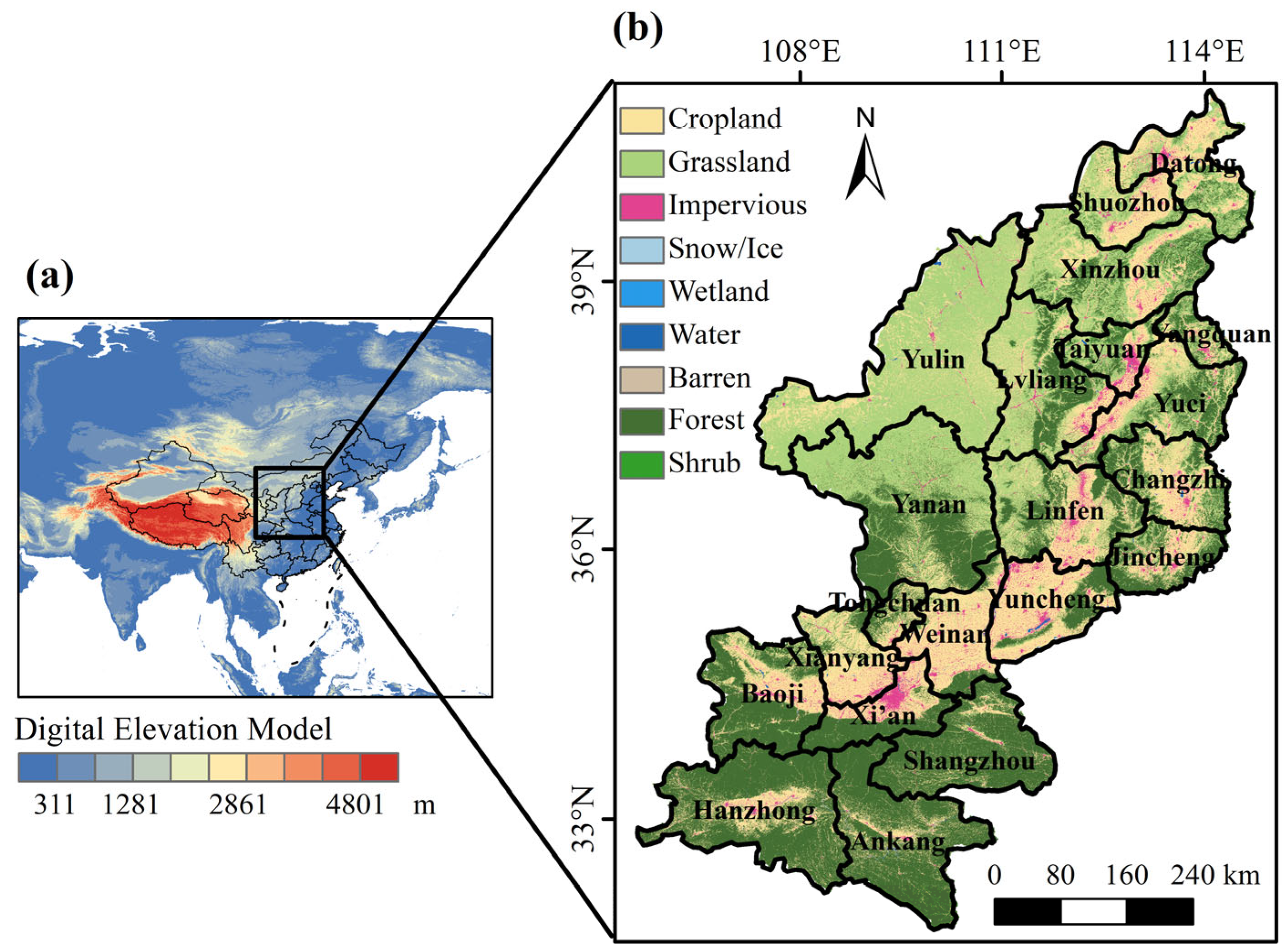


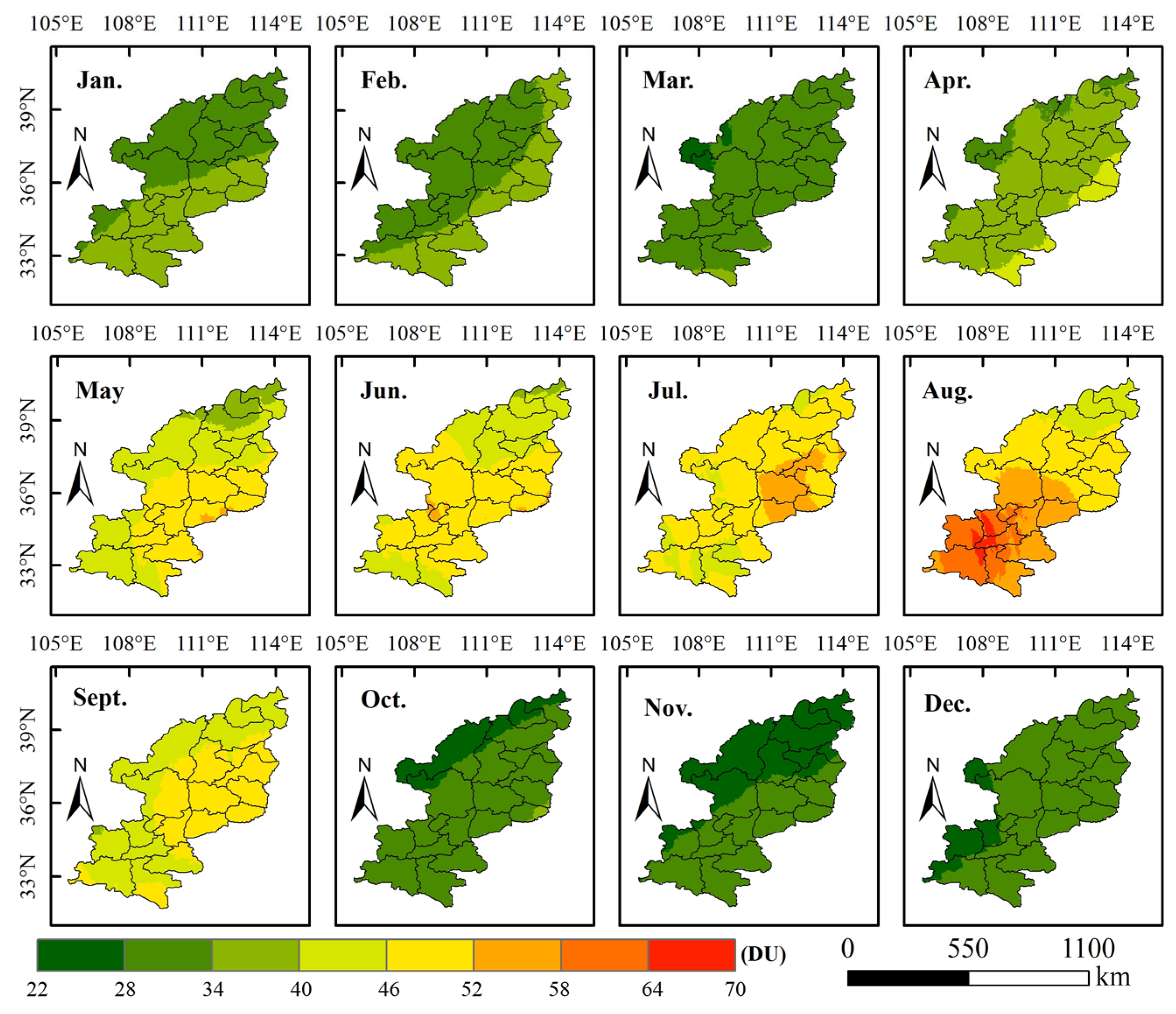
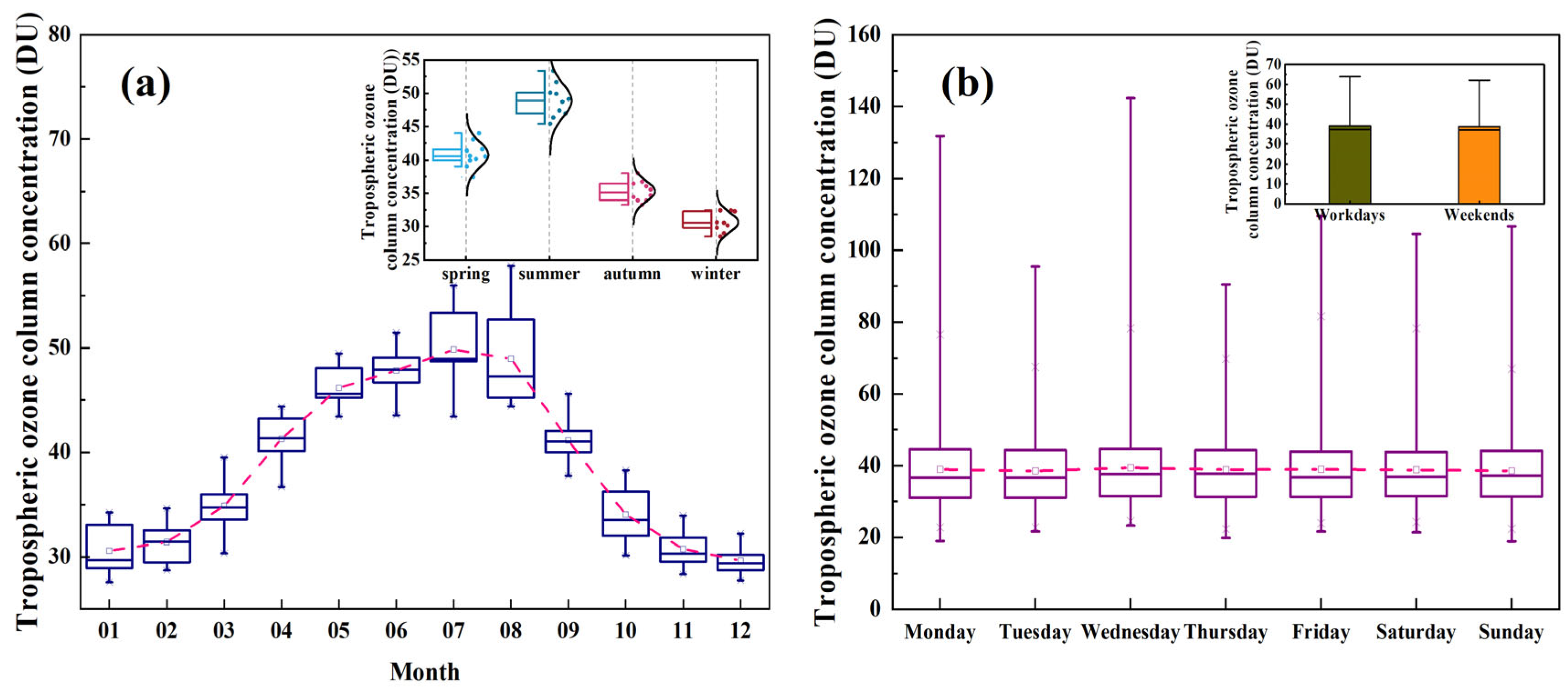

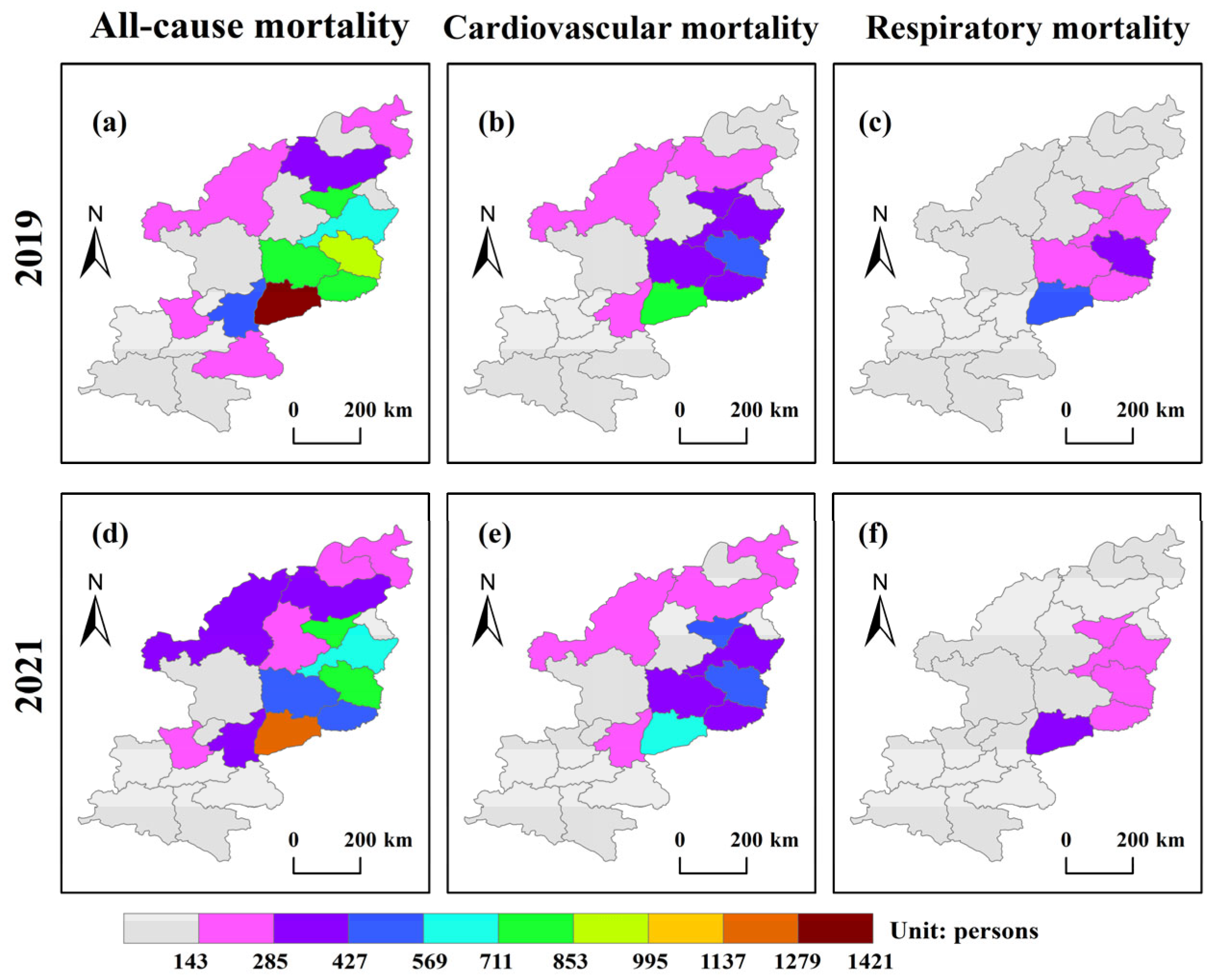

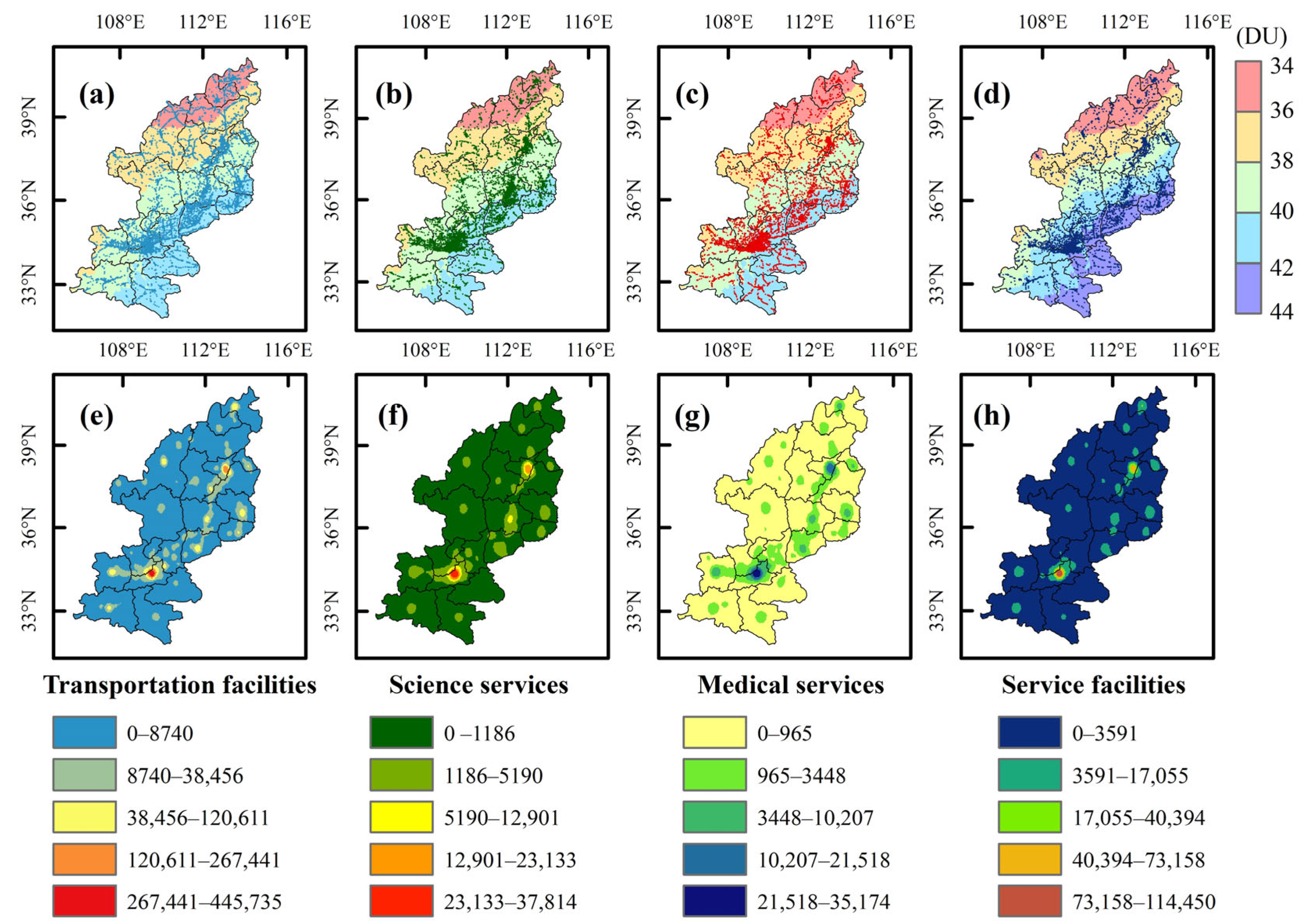
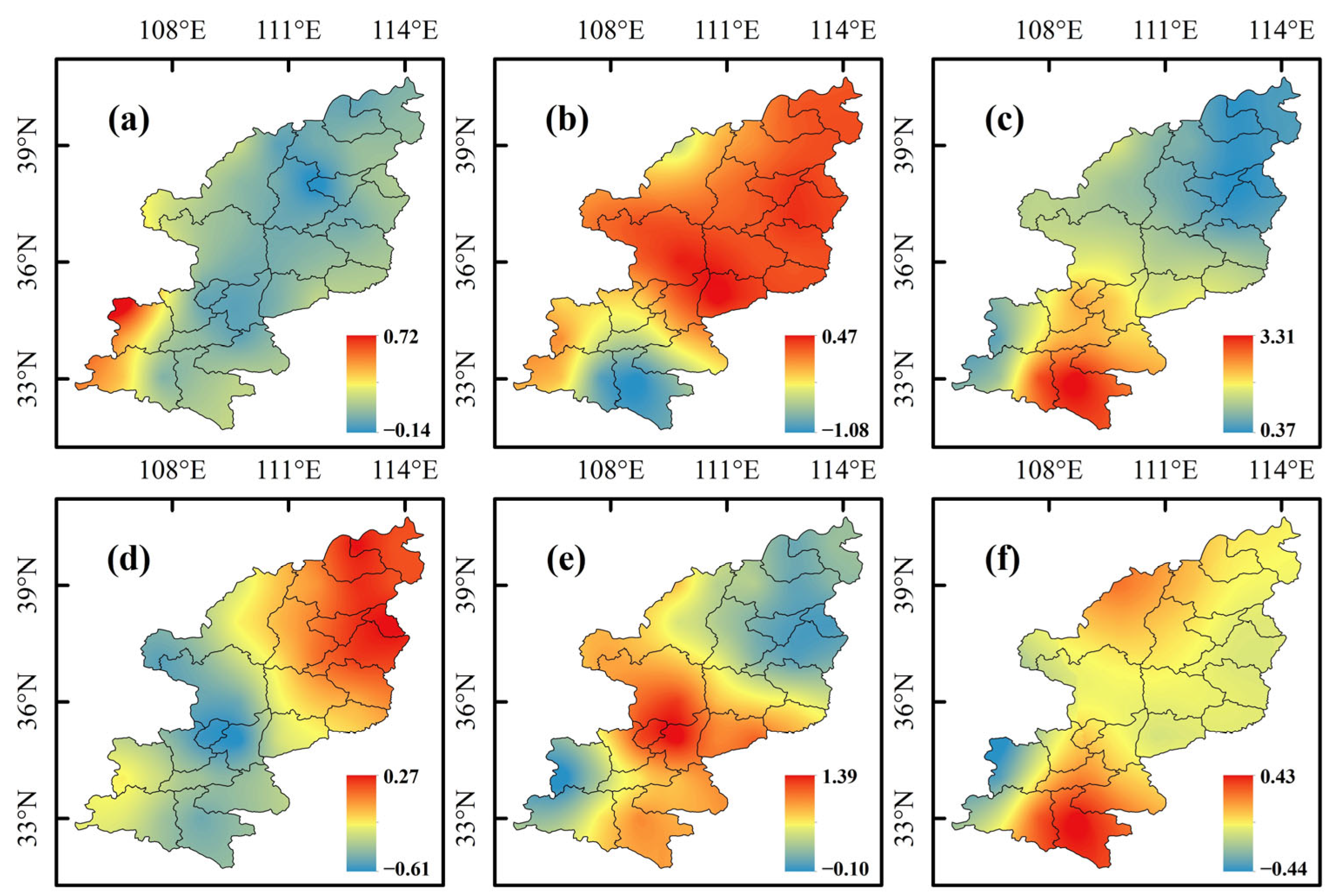
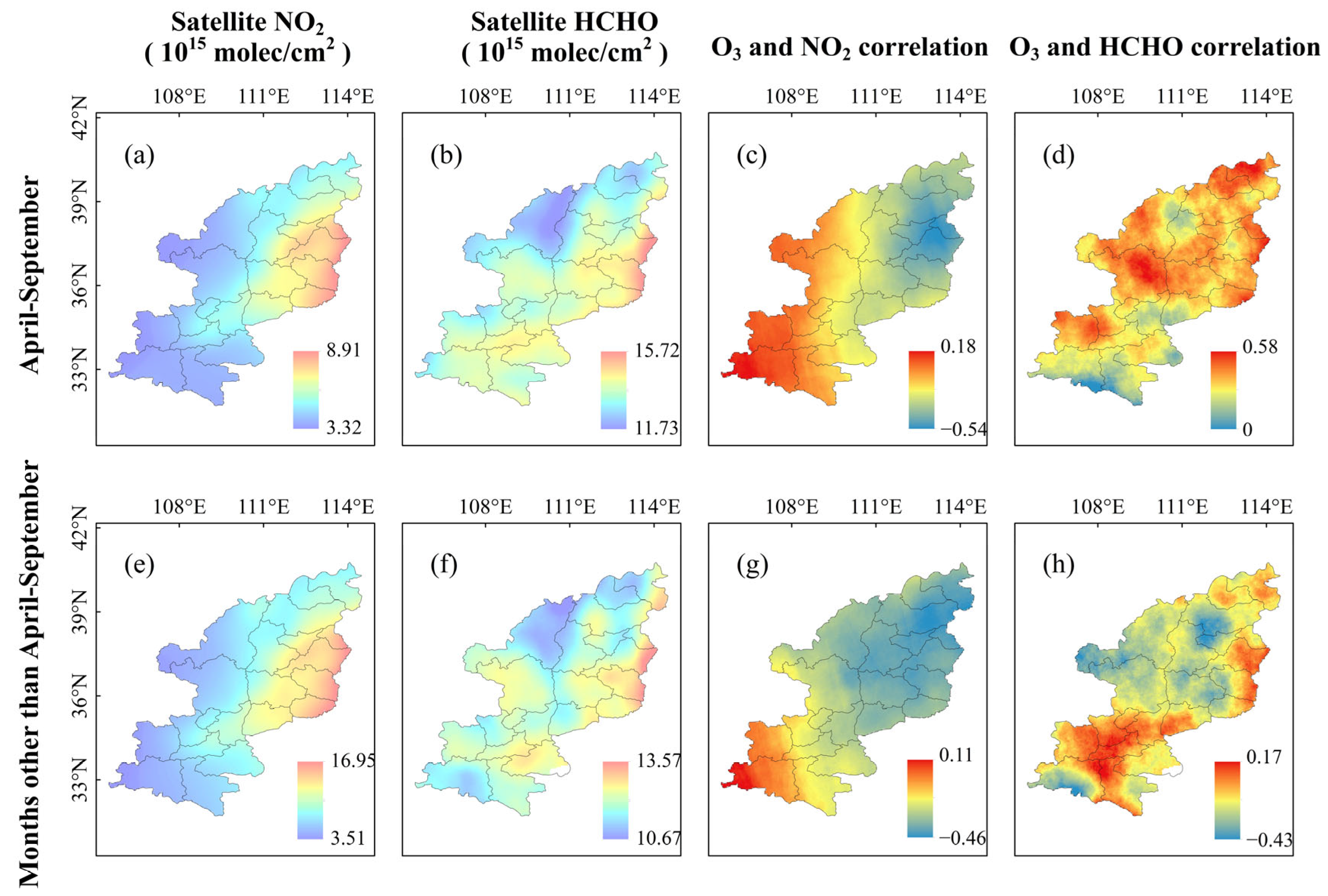
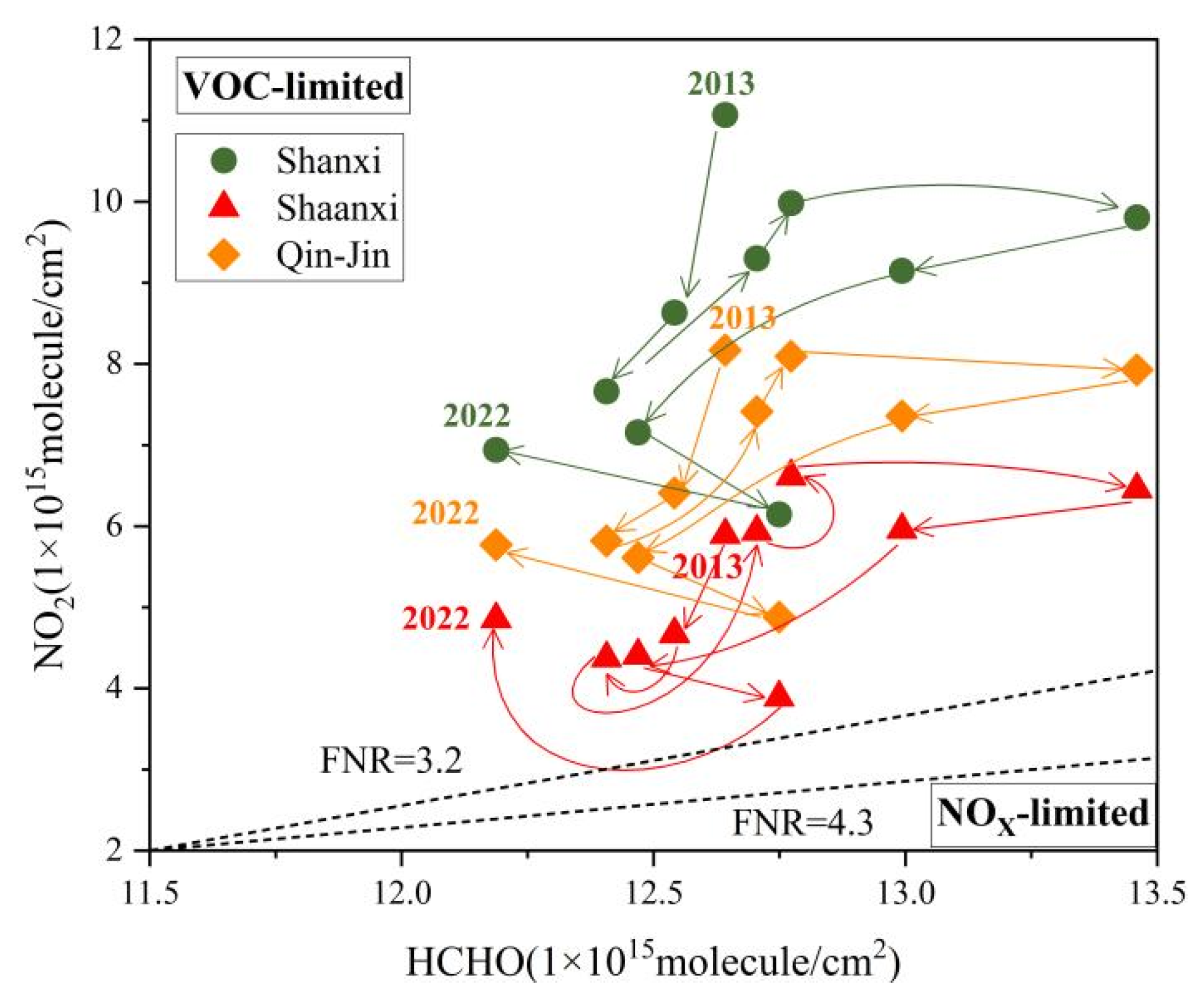

| Health Effect Terminal | β (%) | 95%CI (%) |
|---|---|---|
| All-cause mortality [20] | 0.024 | 0.013–0.035 |
| Cardiovascular mortality [20] | 0.027 | 0.010–0.044 |
| Respiratory mortality [21] | 0.073 | 0.049–0.097 |
| Region | All-Cause Mortality (In Persons, 95%CI) | Cardiovascular Mortality (In Persons, 95%CI) | Respiratory Mortality (In Persons, 95%CI) | |||
|---|---|---|---|---|---|---|
| 2019 | 2021 | 2019 | 2021 | 2019 | 2021 | |
| Datong | 216 (117, 314) | 276 (150, 401) | 117 (44, 191) | 160 (60, 260) | 71 (48, 94) | 74 (50, 97) |
| Shuozhou | 31 (17, 45) | 145 (79, 211) | 17 (6, 28) | 84 (31, 137) | 7 (10, 14) | 39 (26, 51) |
| Xinzhou | 393 (214, 570) | 358 (195, 520) | 214 (80, 345) | 208 (78, 337) | 87 (128, 168) | 95 (65, 125) |
| Yulin | 280 (152, 406) | 325 (176, 472) | 152 (57, 247) | 189 (70, 306) | 62 (92, 122) | 87 (59, 115) |
| Yanan | 67 (36, 98) | 58 (31, 84) | 36 (14, 59) | 34 (12, 54) | 15 (22, 30) | 16 (10, 21) |
| Baoji | 86 (46, 125) | 100 (54, 146) | 47 (17, 76) | 58 (22, 95) | 28 (19, 38) | 27 (18, 36) |
| Hanzhong | 10 (5, 14) | 25 (13, 36) | 5 (2, 9) | 14 (5, 23) | 3 (2, 4) | 7 (4, 9) |
| Ankang | 11 (6, 17) | 51 (27, 74) | 6 (2, 10) | 30 (11, 48) | 4 (2, 5) | 14 (9, 18) |
| Shangzhou | 176 (96, 256) | 119 (64, 173) | 96 (36, 155) | 69 (26, 112) | 58 (39, 77) | 32 (22, 42) |
| Xi’an | 4 (2, 6) | 15 (8, 22) | 2 (1, 4) | 9 (3, 14) | 1 (0, 2) | 4 (3, 5) |
| Weinan | 480 (261, 697) | 329 (179, 479) | 261 (97, 423) | 192 (71, 311) | 106 (158, 208) | 88 (60, 117) |
| Tongchuan | 74 (40, 107) | 30 (16, 44) | 40 (15, 65) | 18 (6, 28) | 16 (24, 32) | 8 (5, 11) |
| Xianyang | 250 (136, 364) | 196 (106, 286) | 136 (51, 221) | 114 (42, 186) | 83 (56, 110) | 53 (36, 70) |
| Yuncheng | 1421 (779, 2049) | 1210 (662, 1747) | 772 (291, 1235) | 703 (264, 1128) | 451 (310, 585) | 315 (216, 410) |
| Jincheng | 769 (424, 1101) | 558 (305, 806) | 416 (159, 660) | 324 (122, 520) | 237 (166, 304) | 145 (100, 189) |
| Changzhi | 953 (522, 1373) | 757 (414, 1094) | 517 (195, 827) | 440 (165, 706) | 301 (208, 391) | 198 (135, 258) |
| Linfen | 727 (397, 1053) | 522 (284, 757) | 395 (148, 637) | 303 (113, 490) | 236 (161, 308) | 139 (94, 182) |
| Taiyuan | 774 (422, 1123) | 778 (424, 1128) | 421 (157, 680) | 452 (169, 731) | 253 (172, 332) | 207 (140, 271) |
| Lvliang | 143 (77, 208) | 146 (79, 212) | 78 (29, 126) | 85 (31, 138) | 47 (32, 63) | 39 (26, 52) |
| Yuci | 570 (310, 825) | 574 (313, 831) | 310 (116, 499) | 334 (125, 538) | 185 (126, 242) | 152 (103, 199) |
| Yangquan | 72 (39, 105) | 113 (61, 164) | 39 (14, 64) | 66 (24, 106) | 24 (16, 31) | 30 (20, 40) |
| Region | Year | Disease Name | Number of Premature Deaths (In Persons, 95%CI) | Economic Loss (Hundred Million RMB, 95%CI) |
|---|---|---|---|---|
| Shanxi | 2019 | All-cause mortality | 4591 (2500, 6659) | 433 (236, 628) |
| Cardiovascular mortality | 2496 (932, 4034) | 235 (88, 380) | ||
| Respiratory mortality | 1499 (1018, 1969) | 141 (96, 186) | ||
| 2021 | All-cause mortality | 4214 (2293, 61,170) | 513 (279, 745) | |
| Cardiovascular mortality | 2450 (914, 3965) | 298 (111, 483) | ||
| Respiratory mortality | 1123 (761, 1478) | 137 (93, 180) | ||
| Shaanxi | 2019 | All-cause mortality | 2498 (1356, 3634) | 235 (128, 342) |
| Cardiovascular mortality | 1359 (505, 2207) | 128 (48, 208) | ||
| Respiratory mortality | 826 (557, 1091) | 78 (52, 103) | ||
| 2021 | All-cause mortality | 1535 (832, 2235) | 187 (101, 272) | |
| Cardiovascular mortality | 893 (332, 1452) | 109 (40, 177) | ||
| Respiratory mortality | 415 (279, 549) | 50 (34, 67) |
| Variables | Pearson | VIF | Min. | Max. | Median | Average |
|---|---|---|---|---|---|---|
| NDVI | 0.664 ** | 3.090 | −0.713 | 0.813 | 0.034 | 0.044 |
| TPW | 0.811 ** | 9.017 | −3.514 | 4.124 | 0.428 | 0.508 |
| TEM | 0.891 ** | 9.788 | −3.883 | 4.302 | 0.309 | 0.302 |
| PS | 0.008 * | 1.261 | −2.993 | 1.266 | 0.025 | 0.041 |
| LI | −0.796 ** | 5.557 | −2.709 | 4.809 | −0.010 | −0.012 |
| RH | 0.206 ** | 2.842 | −2.593 | 0.984 | −0.240 | −0.295 |
Disclaimer/Publisher’s Note: The statements, opinions and data contained in all publications are solely those of the individual author(s) and contributor(s) and not of MDPI and/or the editor(s). MDPI and/or the editor(s) disclaim responsibility for any injury to people or property resulting from any ideas, methods, instructions or products referred to in the content. |
© 2023 by the authors. Licensee MDPI, Basel, Switzerland. This article is an open access article distributed under the terms and conditions of the Creative Commons Attribution (CC BY) license (https://creativecommons.org/licenses/by/4.0/).
Share and Cite
Lei, S.; Ju, T.; Li, B.; Wang, J.; Geng, T.; Huang, R. Study on Spatial Characteristics, Health Assessment, and Influencing Factors of Tropospheric Ozone Pollution in Qin–Jin Region, 2013–2022. Sustainability 2023, 15, 16945. https://doi.org/10.3390/su152416945
Lei S, Ju T, Li B, Wang J, Geng T, Huang R. Study on Spatial Characteristics, Health Assessment, and Influencing Factors of Tropospheric Ozone Pollution in Qin–Jin Region, 2013–2022. Sustainability. 2023; 15(24):16945. https://doi.org/10.3390/su152416945
Chicago/Turabian StyleLei, Shengtong, Tianzhen Ju, Bingnan Li, Jinyang Wang, Tunyang Geng, and Ruirui Huang. 2023. "Study on Spatial Characteristics, Health Assessment, and Influencing Factors of Tropospheric Ozone Pollution in Qin–Jin Region, 2013–2022" Sustainability 15, no. 24: 16945. https://doi.org/10.3390/su152416945





